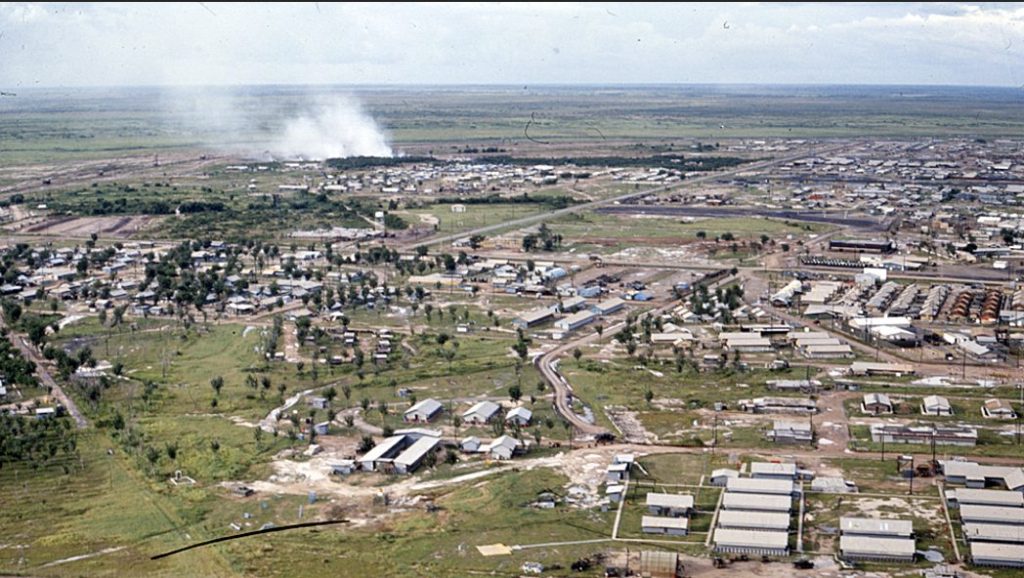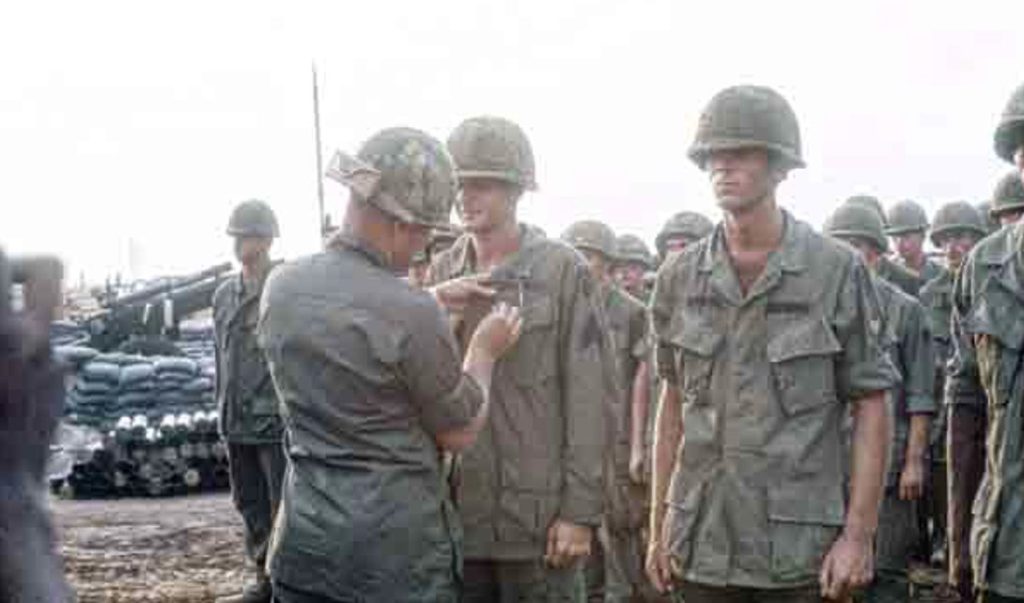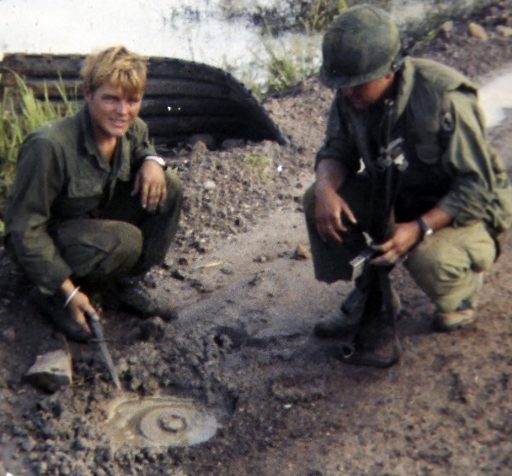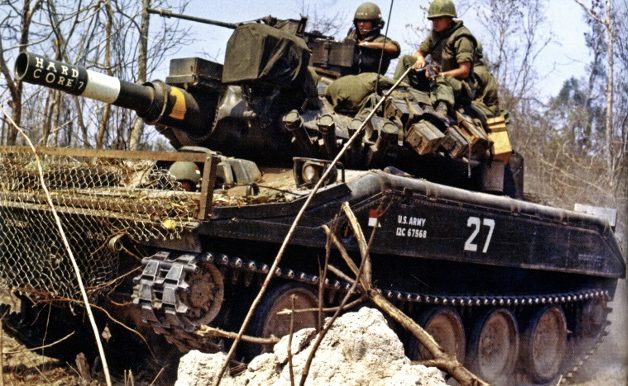
In early November 1970, it was announced that the 25th Infantry Division would be ceasing combat operations before the end of the year. That same week I was helicoptered from the field to the squadron headquarters at Chu Chi to receive, along with a dozen other soldiers, a Purple Heart resulting from my injuries in September.

Despite the short time remaining, the squadron had been assigned a new commander whom I met for the first time. With Army units being withdrawn throughout Vietnam, there was a concerted effort to provide “combat command time” to as many officers as possible. My West Point classmates and I, who began arriving in Vietnam in the summer of 1970, would suffer from this unofficial practice more than any other academy class. In my first ten months in Vietnam as a Lieutenant I would serve under five Captains and four Colonels, not a good situation for any junior officer in wartime.
The final four weeks in the field would be a period of intense activity for me and my platoon. We provided security while combat engineers recovered Bailey bridges, used our demolitions to destroy contaminated fuel at an abandon artillery fire base, conducted a final recon of previous areas of enemy activity, and provided road security for numerous truck convoys. As our divisional units withdrew our local Viet Cong used the opportunity to mine our withdrawal routes and harass us with occasional mortar fire while avoiding any significant engagements.
The main road we were responsible for securing was unpaved and ideal for the use of antitank mines. We were particularly wary of the many civilian mopeds from which a mine could be dropped undetected into a puddle of water. We quickly learned that when local traffic started avoiding a spot in the road there was probably a good reason. Many of my NCO’s, had first-hand experience with mines and stayed away from them. Some of my younger soldiers, however, loved the challenge of being the first to find one and to probe it with their bayonet. I was impressed with the skill with which they could disarm a mine and their bravery, or maybe foolishness.
In mid-November my platoon was given the mission of conducting reconnaissance in a remote area. The only access to the site was along a old logging road bordered by dense jungle. The dirt road was only wide enough for a single vehicle, and as the road narrowed, I became very anxious about the potential for my APC’s running over a mine. I decided to dismount my vehicle with four infantry soldiers and walk in front of the lead vehicle, hoping to find any mines in shallow soil. We had gone about a half mile when there was a huge explosion, the force of which blew me and my infantry to the ground. The third vehicle in my column, in which my platoon sergeant was riding, had hit a large mine.
I immediately ran back to the vehicle to see if anyone was wounded. The first thing I noticed was that the heavily armored cupola that sits on top of the vehicle with a 50-caliber machine gun had been blown off and was nowhere to be seen. I did not see the track commander who had been sitting in the cupola either. I immediately assumed the worst. I climbed on the top of the vehicle and looked into the crew compartment to see my platoon sergeant and two other soldiers staring at me with dazed eyes and blood dripping from their ears, a sign of a concussion. “Are you ok?” I yelled. They looked up at me, saying nothing, and I immediately shouted, “medic.” I looked down into the driver’s compartment and saw the unconscious driver with his head hanging down. As I reached down to pull him out of his seat, his head fell back, and I noticed a large piece of metal from the floor armor had been blown up into his neck and that he was bleeding from several wounds in his stomach. Doc, our medic, was right behind me, and he and several others lifted the driver out. Doc immediately began trying to stop the bleeding from the driver’s neck and stabilize his condition.
I ran to my command track and called on the radio for helicopter medevac of my five wounded soldiers. As I was doing so, the track commander, who had been sitting in the cupola came staggering out of the jungle. The mine had blown him into the air and landed him fifty feet away. Miraculously, he had not been seriously wounded or injured. Four of the soldiers, including my platoon sergeant, would be medevac’d but would recover and continue their Vietnam tours. The seriously injured driver, however, was flown to Japan for further medical treatment. The division surgeon would later credit my medic, with saving the driver’s life that day.
One day on road security, we had a break, and I directed my vehicle commanders to use the time to clean the trash out of their vehicles and burn it. Specialist Carson was my track commander and one of the most professional soldiers in my platoon. He immediately dug a sump pit and began throwing our vehicle trash inside. In keeping with a common practice in the field, I cut a piece of C4 explosive and tossed it in the hole, knowing that it would not explode but would create a very hot fire. I picked up a half empty C ration box and without thinking, threw it in the hole. In my haste I failed to notice that the box included a can of baked beans that had not been opened. Specialist Carson, who was about six feet away from the burning fire, started to say something to me, when suddenly “Crack.” The can of beans suddenly exploded. Carson walked over to me, blood dripping from his face and I realized a piece of metal from the exploding can had struck him right between his eyes. As he stood there, I reached with my hand, pulled the piece of metal from the bridge of his nose. He insisted he was alright, but I ordered him to “Go see the medic and get it bandaged.” He came back later with a small band-aid on his nose, which brought relief and laughter to all of us. I still feel bad to this day that I had been so careless.
By the end of November, we were in the last week of combat operations. For our last night in the field our new squadron commander brought elements from all three cavalry troops together in a single night position. In the middle of our defensive perimeter were a half-dozen M577 squadron command and control vehicles with their large tents extended. We made an easy target for any Vietcong who might want to fire a mortar or rocket. As it turned out, one did.
A single enemy soldier crawled in a ditch along the road near our position and just before nightfall, fired a rocket-propelled grenade at one of our Sheridan tanks. Each Sheridan carried a roll of heavy mesh wire placed in front of the vehicle at night to protect against just such a threat. When the RPG hit the mesh wire, it detonated prematurely but several men relaxing on the back of the Sheridan were hit with fragments.
Hearing the explosion and the call for “medic”, we all ran to our armored vehicles and prepared for action. For a moment, everything was quiet. As I glanced across the perimeter, I observed a crewmember hastily trying to fire a night flare that was not well aimed. It hit the 50-caliber machine gun and bounced back, creating a bright flash inside his vehicle. The appearance to everyone was that the track had been hit by enemy fire.
Suddenly the entire squadron spontaneously opened fire with 50-caliber machine guns and small arms. The noise was deafening as three cavalry troops unleashed tens of thousands of 50-caliber rounds from our position. After several minutes of continuous firing and total confusion, “cease fire” came over the radio and the firing stopped almost as quickly as it had started. This “mad minute” was probably one of the few times in the entire war that the squadron had fought as a single unit. We had three soldiers slightly wounded and no confirmed damage to the enemy. it was a fitting ending to our last night in the field.
After almost five years of deployment in Vietnam, 3rd Squadron 4th Cavalry returned to Cui Chi for the last time on 1 December 1970. That day was one of the last we would all be together as almost immediately reassignment orders started arriving and vehicle and equipment turn-in in Long Bien began. There would be no “job well done” formation except for the small contingency of officers remaining a month later with nothing but the squadron colors. With my platoon sergeant still in the hospital I had no time to reminisce or rest before I departed myself for my new unit four days later. Before I left, I walked around and said good-by to those remaining soldiers from my platoon and fellow officers that I could find. It was not what I would have wanted as a farewell after the experiences we had shared together, but it was what the situation provided. Except for one officer, I would never see any of those I served with in A Troop again.
Two days later I was flying north from Tan Son Nhut Air Base to the highlands of II Corps to my new assignment. Nothing had surprised me more when I had received my orders than to see that my new assignment was the 173rd Airborne Brigade, and specifically the 1st Battalion 503rd Infantry. I was an armor officer, about to be “detailed” as an infantry officer and assigned to an “leg” infantry unit. I couldn’t imagine what job they might have for me, but I was excited about the prospects.




John,
A very gripping story of the war. Thank you for sharing.
Jim
Thanks for sharing your experiences, John!
Thanks for sharing.
John,
Thanks for the memories – remember it well. Was transferred to 2/17 Cav , 101st Abn up north at Camp Eagle next to Hue for my last six months.
Bill (formerly A30 , 3/4 Cav)
Bill. You are the one A Troop alumni that I have seen since that departure day and mentioned in the story. Your platoon sergeant whose name I can’t recall called me some years ago and we had a long conversation. As I recall he had 3 tours in Nam and apparently is still keeping contact with some of the veterans
John
Good memory! My platoon sergeant ( Chester Dowling, e.g. King Worm) was indeed on his third tour, was a year younger than me, and got Purple Hearts 7, 8, and 9 while we served together
Bill
Dear John:
Thanks for sharing! About the can of baked beans, don’t feel too bad. Just think if it would have been ham and lima beans (during Beast, my very first taste of c-rations)! Oh, the humanity! 🙂
REF: https://en.wikipedia.org/wiki/Meal,_Combat,_Individual_ration
Best regards & BOTL,
Bill
Brings back memories as a combat Engineer of moving with the cav along single-lane overgrown “roads” in the bush. Thanks for reminding us of the roles of our field level “docs” — Army medics.
Glad you’re back safely sharing these tales.
John, a most interesting story. I was in a mech infantry stateside unit before going to Vietnam, and remember the M113 & M577 vehicles well. As a platoon leader, once on a multi-day field operation, I noticed all of the fat duffel bags my troops packed on their vehicles. To demonstrate the inadvisability of such action, I told one of the M113 commanders that a landmine just blew off one of his tracks, and he and the crew had to dismount and move their gear on foot. After humping their gear for a few clicks, they got the message. Next time we went out everyone had manageable rucksack sized gear.
Great story! And you got to be a Sky Soldier too.
Well written story, John…content and style…having spent my entire tour June ‘70-‘71 with the 173rd I recall we were happy and lucky to receive battle tested transfers like yourself…Thanks for sharing.
John, thanks for sharing your story. You had already left Vietnam by the time I arrived, but your story reminds me of one thing … each story is unique. I love hearing about them all and thank you for sharing yours. You are a good engaging writer. God bless.
John: Your story brought back memories of things going well and, at other times, not so well. I also felt those moments when skill and cunning didn’t save the day but luck and grace did! Vietnam was a humbling experience for a platoon leader in 1970. Thanks for the memories.
I spent time in the 24th Division well after Vietnam. The Hawaiian Division initially had four brigades. Before WWII it was divided in two new divisions, the 24th and the 25th, each with only two brigades. The 24th stayed that way until after Desert Storm when the 197th Infantry Brigade (Sep) at Ft Benning, which had deployed to Desert Storm with the 24th, was reflagged the 3rd Bde, 24th ID.
John, your APC vs mines stories reminded me of why I chose Infantry. I wanted to take my chances walking on the ground. Looking forward to playing golf with you again in November. I enjoy your detailed memories.
John,
Great story and well written as expected. Thanks for sharing.
Great story. My short tour was with the 173rd in early 1970. There needs to be a Part Two to cover you experiences there.
(Lieutenant Bill Taylor USMA 69 served as the leader of 3rd Platoon alongside Lieutenant John Hamilton. His platoon sergeant SFC Chet Downing was serving his third tour in Vietnam and had been awarded eight Purple Hearts.)
Lt Taylor, I remember your first day after we all got back from Cambodia You
replaced Lieutenant Winters KIA June 10th I would have been with him on that
ambush, but I hit a landmine on the 9th. By the Grace of God, I stayed back to
fix that track vehicle. Sarjerao Yamashita took my place. A day does not go by I don’t
think of him. He was born in the internment Camp California in 1945. Sorry to
say I was told SFC Chet Downing passed away a couple of years ago. I am sure you
will remember me, think about it for a while. Hope Lieutenant Hamilton made
it home safe. 39er
John, you write very well! You may have served with my father Michael Brookover.
Rachel, I thank your father for his service. If he served in the 3/4 Cavalry in 1970 or 1971, I am sure his experiences were similar to my own. I have a book that was hastily put together by the squadron staff in November 1970, as we were standing down, which provides names and pictures of those serving in 3/4 Cav at the time. I did not find your dads’s name, but that does not necessarily mean he was not in our unit. With every soldier serving a 12-month tour, almost half of my platoon came or left during my five and a half months as a platoon leader. Your fasther could have served in my troop or another one in the sqaudron and gone home or been reassigned before November 1970. Glad you enjoyed my story.